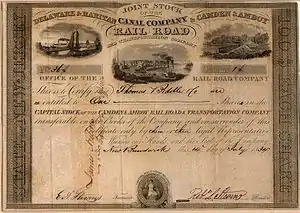Robert L. Stevens
Colonel Robert Livingston Stevens (October 18, 1787 – April 20, 1856) was an American inventor and steamship builder who served as president of the Camden and Amboy Railroad in the 1830s and 1840s.[1]
Robert Livingston Stevens | |
|---|---|
 | |
| Born | October 18, 1787 |
| Died | April 20, 1856 (aged 68) |
| Occupation | Steamship builder |
| Parent(s) | Rachel Cox John Stevens III |
| Relatives | John Cox Stevens (brother) Edwin A. Stevens (brother) |
| Signature | |
Early life
Stevens was born in Hoboken, New Jersey on October 18, 1787. He was the second son of thirteen children born to Rachel (née Cox) Stevens and Colonel John Stevens III.[2] His siblings included older brother John Cox Stevens, the first commodore of the New York Yacht Club, and younger brother Edwin Augustus Stevens, who founded the Stevens Institute of Technology.[2]
His paternal grandparents were John Stevens Jr., a prominent New Jersey politician who served as a delegate to the Continental Congress, and Elizabeth (née Alexander) Stevens, who was the daughter of James Alexander, the Attorney General of New Jersey, and Mary (née Spratt) Provoost Alexander, a prominent merchant.[3] His aunt Mary Stevens married Robert R. Livingston, the first Chancellor of the State of New York.[4]
Career

In 1807, the Stevens and their father built the Phœnix, a steamboat which became the first to navigate the ocean successfully when she traveled from New York City to the Delaware River in 1809.[5] The Phœnix could not operate in the harbor at New York City because Robert Fulton and his partner Robert Livingston, the U.S. Minister to France, had obtained a monopoly there.[6]
Robert Stevens applied the wave line, concave waterlines on a steamboat hull, in 1808, as well as other improvements to shipbuilding. He and his brother, James, involved with the passenger steamship business on the Hudson River in 1834, and both were members of the Hudson River Steamboat Association, a cartel which sought a monopoly on passenger traffic between New York City and Albany.[7]
Stevens was president of the Camden and Amboy Railroad (C&A) in the 1830s and 1840s.[5] When the John Bull steam locomotive arrived on the C&A property, it was originally named Stevens in his honor. Although his father is occasionally credited with the invention of the flanged T rail for railways, Robert Stevens at 42 is considered to have been the inventor of the first all-iron rail construction of the Camden & Amboy. Before 1831, the rails of all previous American railroads were strap iron rails made of wood with a metal strap applied to the wood. One of the two men had traveled to England to purchase the new rails since there was no rolling mill in the United States that was capable of producing the rails. The flat bottomed rail profile is used by railways of every nation. It replaced the cast-iron edge rails that had been introduced in England in 1789, which were made without flanges; instead, flanges were placed on the wheels. (The flanged T rail was introduced in England in 1836 by engineer Charles B. Vignoles (1793-1875), therefore the term "Vignoles rails" came into use in Europe).[8]
He invented a percussion shell, the rights to which he sold to the government.[9] In 1842, he was commissioned by the government to build the first ironclad warship ever constructed,[10] but he died without ever completing it.[11]
Stevens, who never married, died in Hoboken on April 20, 1856.[12]
References
- "Robert Livingston Stevens | American engineer". britannica.com. Encyclopedia Britannica. Retrieved 29 March 2018.
- Cox, Henry Miller (1912). The Cox Family in America: A History and Genealogy of the Older Branches of the Family from the Appearance of Its First Representative in this Country in 1610. Publisher Not Identified. pp. 223–227. Retrieved 18 January 2018.
- The New York Genealogical and Biographical Record, Vol. XI. New York City: New York Genealogical and Biographical Society. 1880. Retrieved December 1, 2017.
- Livingston, Edwin Brockholst (1910). The Livingstons of Livingston Manor: Being the History of that Branch of the Scottish House of Callendar which Settled in the English Province of New York During the Reign of Charles the Second; and Also Including an Account of Robert Livingston of Albany, "The Nephew," a Settler in the Same Province and His Principal Descendants. Knickerbocker Press. Retrieved 10 August 2017.
- Hess, Stephen (2017). America's Political Dynasties. Routledge. p. 555. ISBN 9781351532150. Retrieved 29 March 2018.
- The National Cyclopaedia of American Biography: Being the History of the United States as Illustrated in the Lives of the Founders, Builders, and Defenders of the Republic, and of the Men and Women who are Doing the Work and Moulding the Thought of the Present Time. J. T. White Company. 1901. Retrieved 18 January 2018.
- Renehan, Edward (2009). Commodore: The Life of Cornelius Vanderbilt. New York: Basic Books. pp. 127–128. ISBN 9780465002566.CS1 maint: ref=harv (link)
- Treese, Lorett (2006). Railroads of New Jersey: Fragments of the Past in the Garden State Landscape. Stackpole Books. pp. 22–23. ISBN 9780811732604. Retrieved 29 March 2018.
- Tucker, Spencer (2002). A Short History of the Civil War at Sea. Rowman & Littlefield. p. 1. ISBN 9780842028684. Retrieved 29 March 2018.
- Roberts, William H. (2007). Civil War Ironclads: The U.S. Navy and Industrial Mobilization. JHU Press. p. 121. ISBN 9780801887512. Retrieved 29 March 2018.
- "IRON-CLAD WAR VESSELS.; Historical Sketch of Inventions and Invent ors Errors Corrected". The New York Times. 26 March 1862. Retrieved 29 March 2018.
- Hendrickson III, Kenneth E. (2014). The Encyclopedia of the Industrial Revolution in World History. Rowman & Littlefield. p. 911. ISBN 9780810888883. Retrieved 29 March 2018.
For further reading
- Today in Science History: October 18. Retrieved October 18, 2005.
- Iles, George (1912), Leading American Inventors, New York: Henry Holt and Company, pp. 28–34